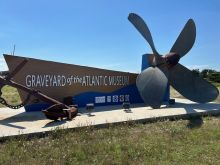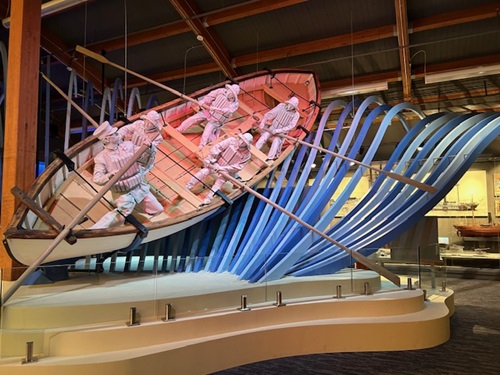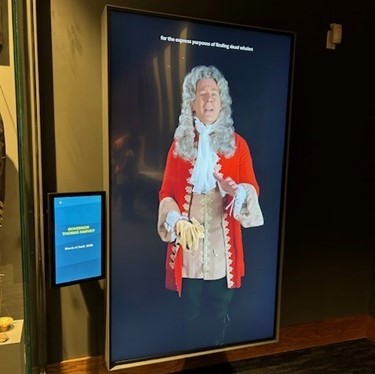
Built to share the remarkable maritime history of Hatteras Island, the Graveyard of the Atlantic Museum has been an impressive attraction on Hatteras Island since 2002. But thanks to a $5.1 million upgrade, the museum is more amazing than ever and feels brand new.
Down at the southern end of Hatteras Island near the Hatteras-Ocracoke Ferry docks, the Graveyard of the Atlantic Museum is part of the North Carolina Maritime Museums, which also includes sites in Southport and Beaufort to tell the stories of North Carolina's coastal history. The Graveyard of the Atlantic Museum is named for the thousands of shipwrecks that have occurred off the coast of Hatteras Island and the North Carolina coast, but shipwrecks are only part of the story. The museum encompasses the full range of Hatteras maritime history, including colonial exploration, piracy, Civil War battles, the U.S. Life-Saving Service, lighthouses, WWI and WWII U-boat battles, boat building, maritime communications and navigation and so much more.

Photo: An impressive sculpture of a Monomoy lifeboat in service commands attention the exhibit gallery.
The newly renovated museum, which officially opened to the public on May 20, seamlessly incorporates the museum’s collection of historical artifacts and photographs with state-of-the-art touchscreens, holographic videos of historical figures, film and hands-on exhibits to tell the stories and give context to hundreds of years of maritime history – history that is relevant not just to Hatteras Island, but also to our entire country.
One might not expect a museum of this caliber in a remote location like Hatteras village, and the story of its fruition is almost as impressive as the museum itself. Hatteras islanders first floated the idea for the museum decades ago, and it was finally built in 2002, funded in great part by local donations. The museum structure is a beautiful building resembling a ship’s hull, and that has not changed.

Photo: An actor portraying Governor Thomas Harvey tells the story of island residents plundering the wreck of Swift in 1698. Several other holograph videos feature actors telling first-hand stories of war, shipwrecks and life-saving rescues.
The museum grew in stages, and the N.C. Department of Cultural Resources took it over in 2007. In May 2021 the museum received a $4.1 million grant from the N.C. Department of Natural and Cultural Resources. Dare County and the Outer Banks Visitors Bureau added $500,000, and the state added another $400,000. With $5.1 million in hand, renovations of the museum began in the winter of 2022-23, designed and executed by Riggs Ward Design of Richmond, Virginia.
The layout of the museum has been reconfigured. Behind the new welcome desk, where children can pick up a scavenger hunt clipboard, is a huge exhibit on weather and a map of the region. A short film in the entry of the exhibit hall sets the stage for what’s to come, followed by a timeline of Hatteras history. At the center of the gallery is a dynamic sculpture of a Monomoy lifeboat full of U.S. Life-Saving Service surfmen about to capsize on wooden waves. There are holograms of actors depicting real-life historical figures telling their stories of shipwrecks and war, along with static and interactive exhibits. One of the most impressive touch-screen exhibits is a digital tableau showing all the shipwrecks on the North Carolina coast. Touch a dot, and a screen pops up with the wreck details. There are plenty of hands-on exhibits to keep children engaged.

Photo: The original Cape Hatteras Lighthouse Fresnel lens is one of the museum's most prized artifacts.
The museum’s most prized possession is the original Cape Hatteras Lighthouse Fresnel lens. At 20 feet tall, it commands attention in the gallery space. Dating to 1852, it’s one of less than 40 first-order lenses left in the country.
If you’re hopping on the ferry to or from Ocracoke, make time to visit this free museum. You can do a quick tour in about a half-hour, but you could easily spend an hour or more learning from these exhibits.
But trust me when I say it’s worth a daytrip to Hatteras just to go to the museum. The drive along Hatteras Island is amazingly beautiful of course, and after the museum, you can hit the beach access across the street, eat at one of the many Hatteras restaurants, head up to Frisco to visit the Frisco Native American Museum and make stops all along the island.

Photo: Displays combine artifacts and photographs with hands-on displays for additional ways of learning about Hatteras history.
The Graveyard of the Atlantic Museum in Hatteras is open 10 a.m. to 4 p.m. Monday to Friday. Admission is free. For more information, visit graveyardoftheatlantic.com.
June Programs at the Graveyard of the Atlantic Museum
June 4, 11 a.m.: North Carolina Whales: Diversity, Distribution and Conservation
Keith Rittmaster, Beaufort Museum natural science curator and Bonehenge Whale Center director, will share an overview of species he encounters through his work and some of the conservation issues they face.
June 11, 11 a.m.: Early NC Ferry Crossings
Benjamin Wunderly, Beaufort museum education curator, will discuss some colonial-era river crossings and the ferry systems that carried vehicles and passengers to the outer barrier islands of the state’s coast.
June 18, 11 a.m. In the Eye of the Storm: Hurricanes, Archaeological Sites, and Environmental Change in Coastal
Allyson Ropp, a maritime archaeologist and historic preservation archaeological specialist with the North Carolina Office of State Archaeology, will share a presentation that looks at how hurricanes impact the work of finding and preserving history.
June 25, 11 a.m.: U.S. Life-Saving Service
James Charlet has planned an informal lecture on the U.S. Life Saving Service.


 Molly Harrison is managing editor at OneBoat, publisher of OuterBanksThisWeek.com. She moved to Nags Head in 1994 and since then has made her living writing articles and creating publications about the people, places and culture of the Outer Banks.
Molly Harrison is managing editor at OneBoat, publisher of OuterBanksThisWeek.com. She moved to Nags Head in 1994 and since then has made her living writing articles and creating publications about the people, places and culture of the Outer Banks.

